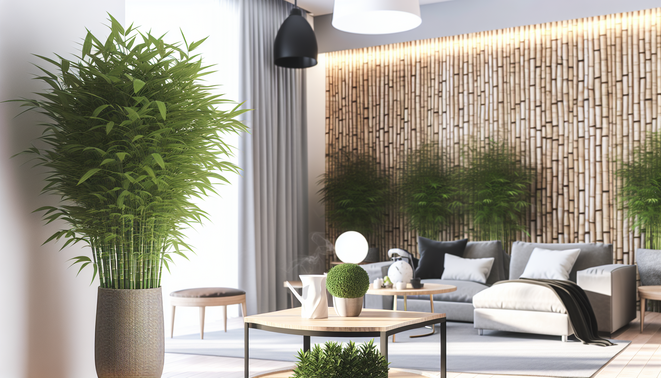Bamboo Decor: Enhancing Aesthetic Appeal and Promoting Sustainability
Bamboo decor items, including furniture, wall art, and decorative pieces, not only enhance the aesthetic appeal of your space but also promote a sustainable lifestyle. Bamboo is recognized for its durability and versatility, making it an ideal material for furniture. Its natural hues can seamlessly blend with various design styles, from rustic to modern, creating a calming atmosphere. Incorporating bamboo wall art adds a unique touch, contributing to a nature-inspired ambiance that brings warmth to any room.
Furniture pieces made from bamboo are lightweight yet sturdy, allowing for easy rearrangement while providing the necessary support for everyday use. Additionally, bamboo decor helps improve indoor air quality, acting as a natural air purifier. This ecological benefit aligns perfectly with the growing trend towards environmentally friendly interior design. For those interested in sustainable living, using bamboo in home decor can significantly elevate both the style and function of your living spaces. Explore more about creating a green home with plants in our article on pet-friendly indoor plants and discover how to merge natural elements into your interior design effectively.
Integrating Bamboo with Other Materials
Integrating bamboo with materials such as wood, stone, and textiles can create a harmonious atmosphere in your home. Here are some practical tips to consider:
- Wood and Bamboo Combos: Bamboo pairs beautifully with wood, especially in furniture and flooring. Opt for bamboo furniture to enhance a natural vibe. To maintain a cohesive look, choose complementary wood tones. For example, light bamboo can be paired with light ash wood for an airy feel, while darker bamboo works well with rich walnut, fostering an earthy, grounded ambiance.
- Stone Accents: Integrating stone elements such as slate or marble with bamboo can add sophistication and texture. Consider using stone countertops or floor tiles alongside bamboo cabinetry or shelving. This combination can create stunning contrast while enhancing the organic feel. For an inviting space, include natural stone planters for bamboo plants, integrating greenery within your design.
- Textile Textures: Soft textiles can warm up the hard surfaces of bamboo and stone. Use cushions and throws in natural fibers like cotton or linen that feature earthy tones and textures. Fabrics in shades of green or beige will beautifully complement the bamboo’s aesthetic. Additionally, consider woven baskets for storage that echo the bamboo’s texture, creating a seamless blend of materials.
- Layering Materials: To create depth, layer different materials in your decor. For instance, you can use bamboo wall panels against a backdrop of stone, creating an appealing visual contrast. Accentuate these features with textiles like area rugs or drapes that tie together the room’s color palette.
- Sustainable Touch: Emphasize sustainability in your choices. Bamboo is a renewable resource, and when combined with the natural aesthetics of stone and wood, it heightens the eco-friendly appeal of your space. Look for organic textiles that maintain this philosophy, ensuring your decor is both stylish and responsible.
By thoughtfully blending these materials, you can foster a cohesive, inviting atmosphere that honors the natural beauty of each element. For more ideas on incorporating plants into decor, check out our guide on pet-friendly indoor plants.
Caring for Indoor Bamboo
Indoor bamboo, known for its unique appearance and air-purifying qualities, requires specific care to thrive indoors. Here are essential maintenance tips to keep your bamboo healthy:
- Watering: Bamboo prefers consistently moist soil. Water your bamboo when the top inch of soil feels dry, ensuring that excess water drains away to prevent root rot. Avoid letting the plant sit in standing water.
- Lighting: Place your bamboo in bright, indirect sunlight. While it can tolerate low light, optimal growth occurs in bright conditions. Avoid direct sunlight, which can scorch the leaves. A spot near east or north-facing windows is ideal for this plant.
- Pest Control: Regularly inspect your bamboo for common pests such as spider mites and aphids. If you spot them, treat your plant with insecticidal soap or neem oil. Additionally, wiping the leaves with a damp cloth can help keep pests at bay while promoting healthy growth.
Regularly check for yellowing leaves, as this is often a sign of overwatering or inadequate light. For more detailed insights on caring for your indoor bamboo, you might also find our article on Indoor Bamboo Care Tips helpful.
The Sustainability of Bamboo as an Eco-Friendly Option
Bamboo is an exceptional choice for eco-friendly home decor due to its remarkable sustainability and renewability. As one of the fastest-growing plants on the planet, bamboo can reach maturity in just three to five years, compared to traditional hardwoods that may take decades to grow. This rapid growth not only diminishes deforestation but also allows for continuous harvesting without compromising the health of the ecosystem.
Additionally, bamboo absorbs carbon dioxide and releases more oxygen than many tree species, contributing positively to the environment. Its durability rivals that of hardwood, making it a long-lasting option for furniture and decorative elements. Furthermore, bamboo is often grown without pesticides or fertilizers, reducing the environmental impact during cultivation.
For those interested in incorporating bamboo into their homes, options range from flooring and furniture to decor items, all of which highlight the plant’s natural beauty and unique textures. Investing in bamboo products not only enhances your living space but also supports sustainable practices. For a deeper dive into plant care and sustainable living, check out our articles on indoor bamboo care and other eco-friendly choices for your home.

2 thoughts on “Decorating With Indoor Bamboo: A Sustainable Touch For Your Home”